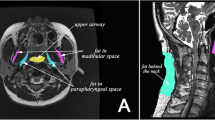Abstract
The purpose of this study was to define the changes in upper airway size in response to a body position change from upright to supine. A total of 15 male Caucasian obstructive sleep apnea (OSA) patients with a mean apnea hypopnea index of 31.0 ± 13.9/hr were recruited for this study. A set of upright and supine cephalograms was traced and digitized for each patient. The most constricted site in the upright position was located in the velopharynx. When the body position was changed from upright to supine, a significant reduction in the anteroposterior dimension was observed only at the level of the velopharynx (p < 0.05). Sagittal cross-sectional areas of the velopharynx and the oropharynx significantly decreased (p < 0.05), but the soft palate area increased (p < 0.05). We conclude that the velopharynx is not only the narrowest site in both upright and supine body positions but also the most changeable site in response to an alteration in body position during wakefulness. Backward displacement of the soft palate with a change in shape may reflect less functional compensation in the velopharynx than that in the oropharynx and the hypopharynx and partly explain why upper airway occlusion occurs primarily in the velopharynx in OSA patients.
Similar content being viewed by others
References
Remmers JE, de GrootWJ, Sauerland EK, Anch AM. Pathogenesis of upper airway obstruction during sleep. J Appl Physiol 1978;44:931–938
Pae EK. A size and shape analysis in obstructive sleep apnea patients [dissertation]. Vancouver, BC: The University of British Columbia; 1993
Kokich V. What’s new in dentistry. Angle Orthod 2000;70:413–414
Kuna ST, Remmers JE. Anatomy and physiology of upper airway obstruction. In: Kryger MH, Roth T, Dement WC, eds. Principles and Practice of Sleep Medicine 3rd ed. Philadelphia: WB Saunders; 2000:840–858
Lowe AA. Oral appliances for sleep breathing disorders. In: Kryger MH, Roth T, Dement WC, eds. Principles and Practice of Sleep Medicine 3rd ed. Philadelphia: WB Saunders; 2000:929–939
Findley LJ, Suratt PM. Serious motor vehicle crashes: the cost of untreated sleep apnoea. Thorax 2001;56:505–505
Cartwright RD. Effects of sleep position on sleep apnea severity. Sleep 1984;7:110–114
McEvoy RD, Sharp DJ, Thornton AT. The effects of posture on obstructive sleep apnea. Am Rev Respir Dis 1986;133:662–666
Elliot AR, Shea SA, Dijk DJ, et al. Microgravity reduces sleep-disordered breathing in humans. Am J Respir Crit Care Med 2001;164:478–485
Horner RL. Motor control of the pharyngeal musculature and implications for the pathogenesis of obstructive sleep apnea. Sleep 1996;19:827–853
Miyamoto K, ÖzbekMM, Lowe AA, Fleetham JA. Effect of body positions on tongue posture in awake patients with obstructive sleep apnoea. Thorax 1997;52:255–259
Mathur R, MortimoreIL, Jan MA, Douglas NJ. Effect of breathing, pressure and posture on palatoglossal tone. Clin Sci (Colch) 1995;89:441–445
Solow B, Tallgren A. Head posture and craniofacial morphology. Am J Phys Anthropol 1976;44:417–436
Tsuiki S, Hiyama S, Ono T, et al. Effects of a titratable oral appliance on supine airway size in awake non-apneic individuals. Sleep 2001;24:554–560
Hiyama S, Ono T, Ishiwata Y, Kuroda T. Supine cephalometric study on sleep-related changes in upper-airway structures in normal subjects. Sleep 2000;23:783–790
Hair JF, Anderson RE, Tatham RL, Black WC. Preparing for a multivariate analysis. In: Hair JF, Anderson RE, Tatham RL, Black WC, eds. Multivariate Data Analysis. 5th ed. Englewood Cliffs, NJ: Prentice-Hall; 1988:33–86
Jan MA, Marshall I, DouglasNJ. Effect of posture on upper-airway dimensions in normal human. Am J Respir Crit Care Med 1994;149:145–148
Pracharktam N, Hans MG, Strohl KP, RedlineS. Upright and supine cephalometric evaluation of obstructive sleep apnea syndrome and snoring subjects. Angle Orthod 1994;64:63–74
Martin SE, Mathur R, Marshall I, DouglasNJ. The effect of age, sex, obesity and posture on upper airway size. Eur Respir J 1997;10:2087–2090
Tsuiki S, Ono T, Kuroda T. Mandibular advancement modulates respiratory-related genioglossus electromyographic activity. Sleep Breathing 2000;4:53–57
Tsuiki S, Ono T, Ishiwata Y, Kuroda T. Functional divergence of genioglossus motor unit with respiratory-related activity. Eur Respir J 2000;15:906–910
Malhotra A, Pillar G, FogelRB, et al. Genioglossal but not palatal muscle activity relates closely to pharyngeal pressure. Am J Respir Crit Care Med 2000;162:1058–1062
Morrison DL, Launois SH, Isono S, et al. Pharyngeal narrowing and closing pressures in patients with obstructive sleep apnea. Am Rev Respir Dis 1993;148:606–611
Van de GraaffWB, Gotteried SB, Mitra J, Van Lunteren E, CherniackNS, Strohl KP. Respiratory function of hyoid muscles and hyoid arch. J Appl Physiol 1984;57:197–204
Lowe AA, Gionhaku N, Takeuchi K, FleethamJA. Three-dimensional CT reconstructions of tongue and airway in adult subjects with obstructive sleep apnea. Am J Orthod Dentofacial Orthop 1986;90:364–374
Lowe AA, Fleetham JA. Two- and three-dimensional analyses of tongue, airway and soft palate size. In: Norton ML, Brown ACD, eds. Atlas of the Difficult Airway. St. Louis, MO: Mosby; 1991:74–82
Pae EK. Cephalometry needs innovation, not renovation. Angle Orthod 1997;67:395–396
Cakirer B, Hans MG, Graham G, Aylor J, Tishler PV, RedlineS. The relationship between craniofacial morphology and obstructive sleep apnea in Whites and in African-Americans. Am J Respir Crit Care Med 2001;163:947–950
Liu Y, Lowe AA, Zeng X, Fu M, FleethamJA. Cephalometric comparisons between Chinese and Caucasian patients with obstructive sleep apnea. Am J Orthod Dentofacial Orthop 2000;117:479–485
Schmidt-Nowara W. Recent developments in oral appliance therapy of sleep disordered breathing. Sleep Breathing 1999;3:103–106
de AlmeidaFR, Bittencourt LR, de AlmeidaCI, Tsuiki S, Lowe AA, TufikS. Effects of mandibular posture on obstructive sleep apnea severity and the temporomandibular joint in patients fitted with an oral appliance. Sleep 2002;25:507–513
Liu Y, Lowe AA, Fleetham JA, ParkY. Cephalometric and physiological predictors of the efficacy of an adjustable oral appliance for the treatment of obstructive sleep apnea. Am J Orthod Dentofacial Orthop 2001;120:639–647
Author information
Authors and Affiliations
Corresponding author
Rights and permissions
About this article
Cite this article
Tsuiki, S., Almeida, F.R., Bhalla, P.S. et al. Supine-Dependent Changes in Upper Airway Size in Awake Obstructive Sleep Apnea Patients. Sleep Breath 7, 43–50 (2003). https://doi.org/10.1007/s11325-003-0043-6
Issue Date:
DOI: https://doi.org/10.1007/s11325-003-0043-6



